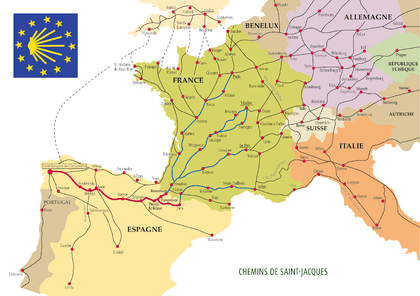Camino Primitivo
| The Primitive Way / Camino Primitivo | |
|---|---|
| Location | Oviedo, Santiago de Compostella |
| Trailheads | Oviedo to Lugo to Santiago de Compostella |
| Use | Hiking |
| Hiking details | |
| Season | All Year |
The Primitive Way (Spanish: Camino Primitivo) is one of the paths of the Camino de Santiago. It begins in the old Asturian capital of Oviedo and runs west to Lugo and then south to Santiago de Compostella joining[1] the more popular French Way in Melide for the last two hiking days.
Middle Ages
The Camino Primitivo is thought of as the "Original Way" because it is reportedly the path taken by the first reported pilgrim Alfonso II of Asturias (c. 760 – 842), nicknamed the Chaste (Spanish: el Casto) in 814 from his capital, Oviedo to the location to be Santiago de Compostela at that time Mount Libredón.[2] He built the original shrine to Saint James on the spot of the discovery.[3] Until the city of León was established as both the capital of the Kingdom of Leon and the nexus of a safe route the French Way across the meseta the Camino Primitivo remained the most frequented route for pilgrims.
Modern revival
The Camino Primitivo remains as a popular alternative path, which avoids the Meseta and the crowds of pilgrims there. It allows hikers to enjoy a more stimulating hike with significant vertical gradients and better views.
In 2013, just over 3% of official pilgrims, that is more than 6,800 per year walked the Camino Primitivo starting almost exclusively at Oviedo.[4]
References
- ↑ Gitlitz & Davidson, The Pilgrimage Road to Santiago: The Complete Cultural Handbook, 2000, St Martin's Press, ISBN 0-312-25416-4
- ↑ "THE WAY - Fundación Arousa. Foundation Arousa. Año Santo Compostelano. Año Jacobeo. Xacobeo 2021. The Route of the sea of Arousa and river Ulla". Fundacionxacobea.com. Retrieved 4 January 2018.
- ↑ Gitlitz & Davidson, The Pilgrimage Road to Santiago: The Complete Cultural Handbook, 2000, St Martin's Press, ISBN 0-312-25416-4
- ↑ "Pilgrim's Reception Office - Cathedral of Santiago". Oficinadelperegrino.com. Retrieved 4 January 2018.
